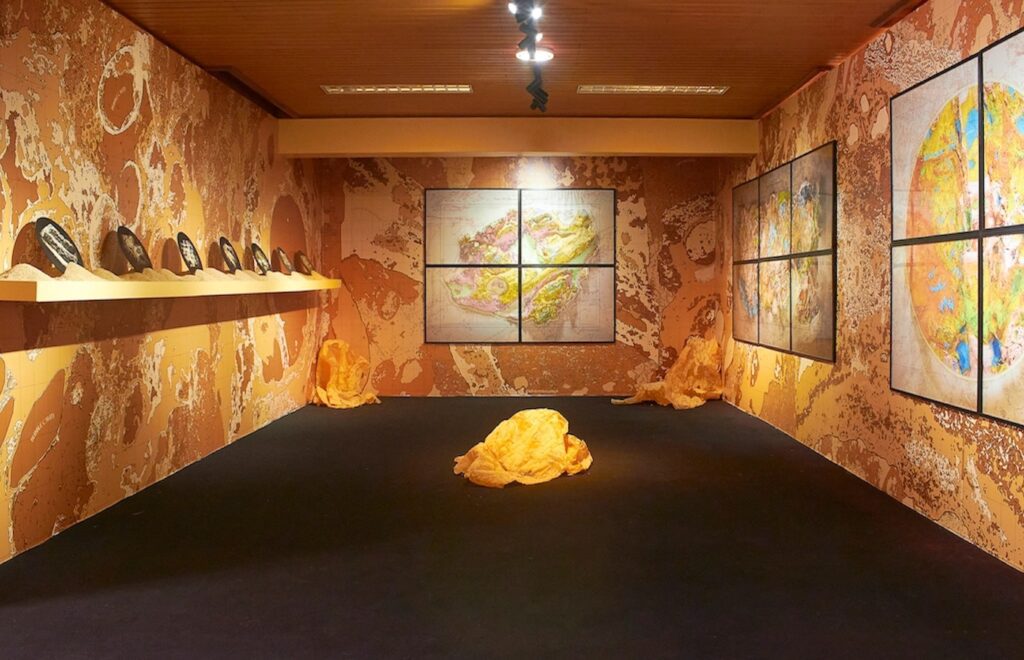Advanced Business College, Accra, Ghana
06 Jul 2024 - 31 Aug 2024

Tracy Naa Koshie Thompson, Worlds within Worlds, installation view, 2024. Courtesy of
Worlds within Worlds, a solo exhibition by artist Tracy Naa Koshie Thompson (b. 1993), is a culmination of years of experimentation, reverse-engineering and close observation of the plasticity of food polymers and their apparent but hidden universes.
Thompson’s interest in deconstructing foods in their material and pictorial representation comes as a critique and expansion of the still-life genre. Thompson’s experimentations are birthed from the revolutionary teachings of Prof. kąrî’kạchä seid’ou who employed his class on still-life, as a means of departure to develop critical attention to small mundane things which may be relegated to the backgrounds of human-centred subjects. The tradition of still-life is typically a pictorial representation of fruits and flowers on a table or banal objects or personal effects, either painted or drawn and sometimes with religious connotations and contemplation of human futility or death (vanitas). What Thompson does, is to go beyond the traditional setting of food on a table for humans, to experiment with foods in themselves, like waakye (rice and beans), fufu, noodles, and jollof rice into new forms. She does this by paying attention to the lively material processes with foods such as fermentation, crystallization, plasticity and other micro-forms and processes that challenge literal representations of foods we are familiar with.
In post-producing foods, she began noticing semblances of starches to geological and biological forms not only at the macro scale but micro as well (simple things like starch cell patterns in banku shishi which has sponge patterns formed at the base of saucepans which can be swollen by water, looking like yem adiɛ). Patterns like cracks, crusts and foaming in starch transformation, set her on a journey of mimicry of geological and biological forms, maps and computational biomimicry which are all coming from the lively intricacies of starches in foods.
Thompson employs ultra-processing and micrography of foods like kanzo – burnt food scraps that congeal at the base of pans after cooking – a delicacy for some in Ghana. Thompson elevates this seemingly banal leftover as the site of intrigue and exploration, research and experimentation. Thompson reverse-engineers software to render 2D images of the micrograph food substrates into 3D topography information using digital elevation modelling (DEM), which aligns with techniques used in geography, animation texture mapping, cartography, and other allied fields, including planetary imaging (remote sensing). This results in a manipulation of material into imagery and vice versa, offering multiple modes for materials to express their beingness. Food becomes plastic, polymers turn to information, images become 3D prints and all of this results in a dynamic learning experience through feedback loops. The works are always teaching me things, Thompson intimated. We can picture this like a Russian matryoshka doll cracked open to reveal its contents that is larger than its container and even sub-dolls within it spatially engulf the beholder.
We become cartographers of antiquity gleaming unto a new terra incognita which could be remnants of alien planets that oscillate between fiction and reality. We may be falling into jollof calderas, and float on a sea that may well be a desert of large flat plains which betray their infinite material depth. A microbe incarnates as a fossilized macro scale creature, dignifying its presence as an actant or the unknown artist.
In Thompson’s new digital work shown in this exhibition, she collaborated with artist Akosua Odeibea Amoah-Yeboah whose practice revolves around creating glitch sounds by force-feeding audio software with text and images — a sonic translation that also recalls a tradition of making maps using sonar readings. Inspired by Thompson’s digital renderings which are coincidentally akin to sonic visualizations, Amoah-Yeboah appends a sonorous dimension to the digital work.
In a time of renewed race for outer space, Thompson invites us to take a journey to the inner spaces of things and consequently ourselves, where exposure to what we know but do not know, becomes a subverse politic act, unseparated from the sensual: what we are allowed or led to see, what we can and cannot dream, and what we can imagine. So the next frontier may not be outer space at all, but planes beyond our psychic technosphere — the inner universes of Worlds within Worlds, where difference can be contested with an intensivity, in scalar and vectorial orientations, creating new terrains where – just maybe, new jollof wars could be fought.
by Patrick Nii Okanta Ankrah